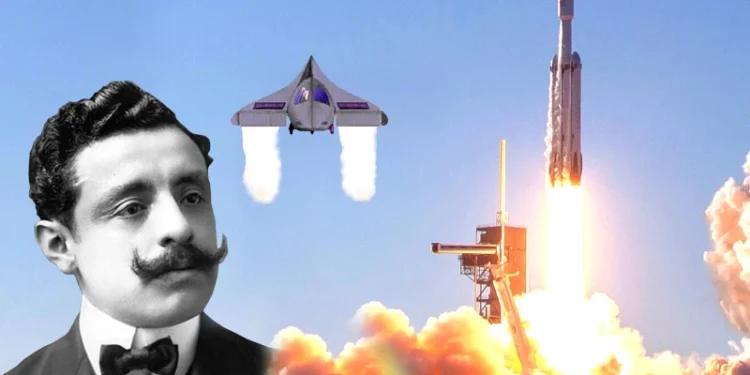This post is also available in:
Español
Nederlands
When we talk about pioneers in the history of space science, names like Wernher von Braun or the Wright brothers usually grab the attention. However, few know the story of a Peruvian genius who, with his intellect and creativity, anticipated the space age decades before the possibility of flying outside the planet even existed. His name is Pedro Paulet, a multidisciplinary sage whose legacy lives on at the heart of modern space exploration. This article unravels his incredible life and the contributions that place him at the forefront of space engineering, a man who, from humility, set out to reach the stars.
Who was Pedro Paulet?
Born in Arequipa, Peru, in 1874, Pedro Paulet Quispe was a true Renaissance man. He was an architect, engineer, chemist, mechanic, economist, geographer, sculptor, diplomat, journalist, inventor and writer. But his greatest contribution to humanity came from his passion for the skies.
Paulet grew up in a humble family and attended school at the Colegio San Vicente de Paúl. From a very young age, he showed an unusual interest in science and engineering, and his hunger for knowledge led him to study at the University of Paris, where in 1900 he achieved his great feat: the construction of the first rocket engine powered by liquid fuel. This engine, which weighed only 2.5 kg, exerted a pressure of 90 kg and produced 300 explosions per minute, was the precursor to the technology that would later allow man to reach the Moon.
The rocket engine that changed history
The engine designed by Paulet was not only an unprecedented technological feat for its time, but its visionary application in aircraft propulsion placed him ahead of the Wright brothers, who in 1903 made the first airplane flight. In fact, in 1902, Paulet presented a project that astonished the scientific community: a propeller-less metal airplane with delta wings and an ovoid cabin. His ingenuity was so ahead of its time that many did not understand the magnitude of his invention.
Paulet’s legacy: From the Earth to the Moon
The impact of Paulet’s discoveries was not relegated to oblivion. NASA recognized his influence on the technology that, years later, would be used for space missions such as Apollo 11. In 1969, when man finally set foot on the lunar surface, Paulet’s work was key to developing the liquid-fuel engines that propelled rockets into space. Today, a plaque at the National Air and Space Museum in Washington, D.C., honors his legacy, reminding the world of the genius who helped put man on the Moon.
Wernher von Braun and the recognition of a genius
Perhaps one of Paulet’s most fervent admirers was the German engineer Wernher von Braun, considered the father of modern rocketry. In his book World History of Aeronautics, von Braun stated that Pedro Paulet should be considered the true pioneer of the liquid-fuel propulsion engine, recognizing the impact of his experiments in the early 20th century. His words reflect the importance of this Peruvian inventor in the history of space exploration.

A life dedicated to science and exploration
Despite his scientific achievements, Paulet faced difficulties throughout his life. In 1941, he accompanied former Peruvian president Oscar R. Benavides as a commercial advisor in Argentina. There, he attempted to found a South American aeronautical industry, but his vision was not fully understood in his time. Sadly, many of his prototypes and designs were lost during the political turmoil of the time.
Paulet dreamed of the stars and set in motion the ideas that would allow humanity to break the barriers of the sky.
He died on January 30, 1945 in Buenos Aires, leaving behind a scientific legacy that was just beginning to be recognized. In his honor, the Peruvian Air Force erected a mausoleum in the Presbítero Maestro Cemetery, where his remains rest beneath a replica of his torpedo plane.
A dream that continued with his daughter
Pedro Paulet’s vision did not die with him. During his life, he shared his passion for space exploration with his daughter, Megan, to whom he said: “When you grow up and my invention becomes a reality, you and I will travel to the moon. And if because of my age I were to die, you would follow in my footsteps.” Although he did not live to see his dream come true, his contributions laid the groundwork for man to reach outer space.
Pedro Paulet was not only a genius in the field of science and engineering, but also a symbol of perseverance and futuristic vision. At a time when flying seemed impossible, Paulet dreamed of the stars and set in motion the ideas that would allow humanity to break the barriers of the sky. His life and legacy are a reminder that talent and passion can overcome any obstacle, even those that seem insurmountable.
Leave us your comments and opinions in the section below. Share this article with your friends and family so that more people know about the incredible legacy of this Peruvian genius! Don’t forget to subscribe to our page to continue learning about the figures who have left their mark on the history of Peru and the world.








